BUMGT5970 Leadership Reflection: Impact of Learning on Style
VerifiedAdded on 2023/04/04
|9
|2105
|378
Essay
AI Summary
This essay provides a comprehensive reflection on leadership concepts learned throughout a course, spanning from foundational definitions to advanced leadership models. It delves into the impact of class activities on the student's leadership capacity and explores the influence of values, culture, and ethics on leadership behavior. The reflection includes a discussion of barriers to promotion, the dynamics of organizational culture, and an analysis of various leadership styles such as transformational, authentic, and servant leadership. Furthermore, it examines the significance of cultural views in global leadership and contrasts leadership development with leader development, highlighting effective training processes. The essay also touches upon the competencies needed in non-profit leadership and contextual variables shaping different leadership approaches. The student reflects on a group assignment experience and a personal work experience involving a change of manager, illustrating the practical implications of leadership theories and their impact on organizational performance and team motivation.
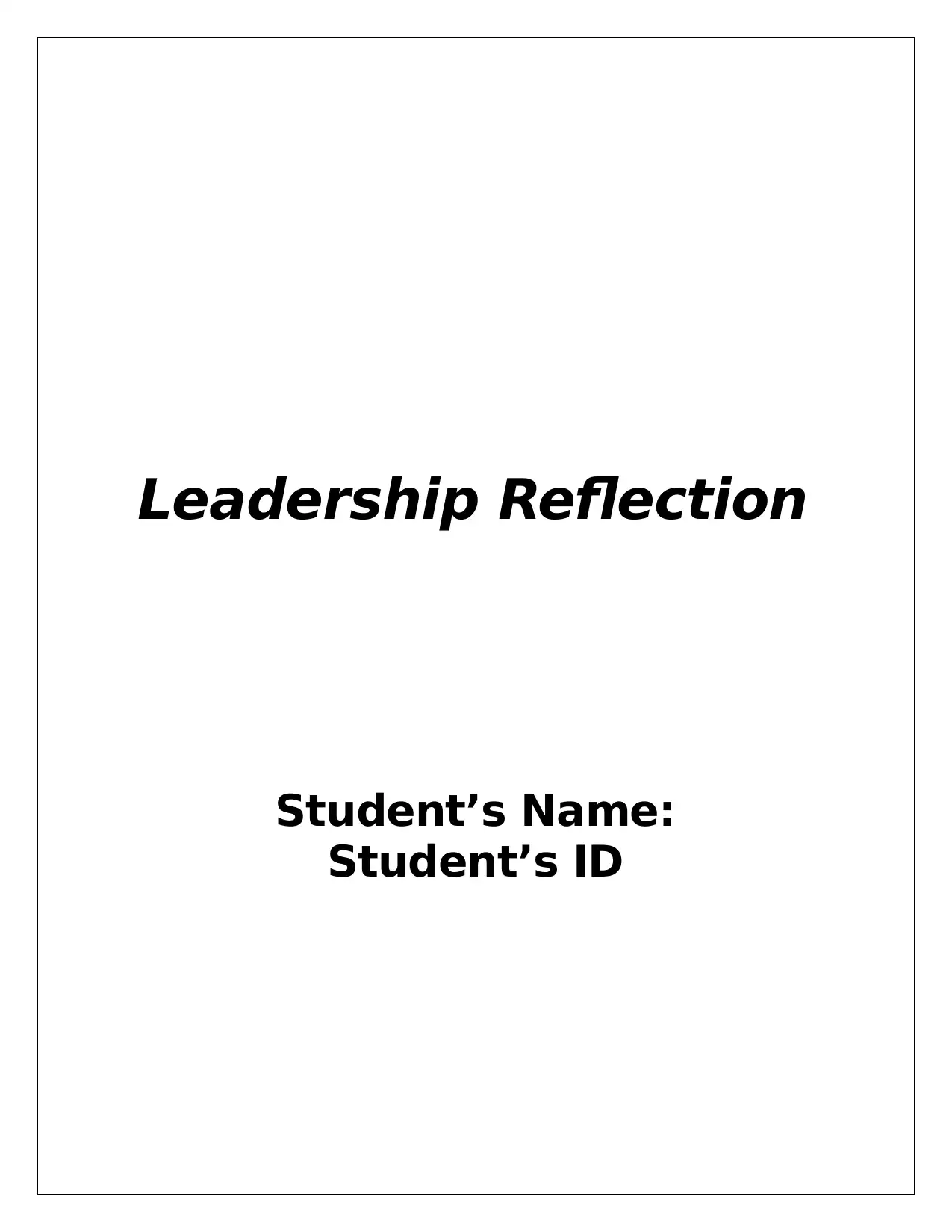
Leadership Reflection
Student’s Name:
Student’s ID
Student’s Name:
Student’s ID
Paraphrase This Document
Need a fresh take? Get an instant paraphrase of this document with our AI Paraphraser
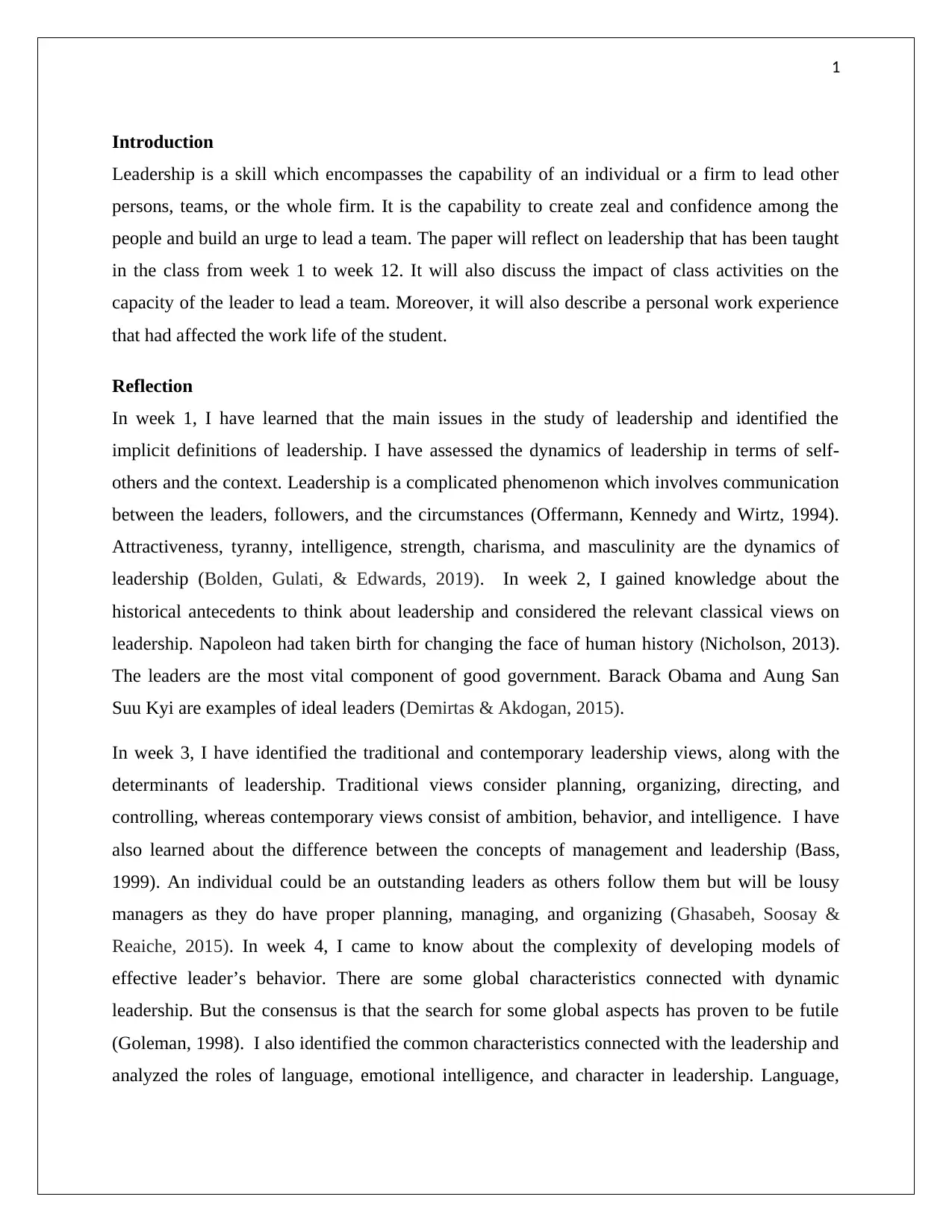
1
Introduction
Leadership is a skill which encompasses the capability of an individual or a firm to lead other
persons, teams, or the whole firm. It is the capability to create zeal and confidence among the
people and build an urge to lead a team. The paper will reflect on leadership that has been taught
in the class from week 1 to week 12. It will also discuss the impact of class activities on the
capacity of the leader to lead a team. Moreover, it will also describe a personal work experience
that had affected the work life of the student.
Reflection
In week 1, I have learned that the main issues in the study of leadership and identified the
implicit definitions of leadership. I have assessed the dynamics of leadership in terms of self-
others and the context. Leadership is a complicated phenomenon which involves communication
between the leaders, followers, and the circumstances (Offermann, Kennedy and Wirtz, 1994).
Attractiveness, tyranny, intelligence, strength, charisma, and masculinity are the dynamics of
leadership (Bolden, Gulati, & Edwards, 2019). In week 2, I gained knowledge about the
historical antecedents to think about leadership and considered the relevant classical views on
leadership. Napoleon had taken birth for changing the face of human history (Nicholson, 2013).
The leaders are the most vital component of good government. Barack Obama and Aung San
Suu Kyi are examples of ideal leaders (Demirtas & Akdogan, 2015).
In week 3, I have identified the traditional and contemporary leadership views, along with the
determinants of leadership. Traditional views consider planning, organizing, directing, and
controlling, whereas contemporary views consist of ambition, behavior, and intelligence. I have
also learned about the difference between the concepts of management and leadership (Bass,
1999). An individual could be an outstanding leaders as others follow them but will be lousy
managers as they do have proper planning, managing, and organizing (Ghasabeh, Soosay &
Reaiche, 2015). In week 4, I came to know about the complexity of developing models of
effective leader’s behavior. There are some global characteristics connected with dynamic
leadership. But the consensus is that the search for some global aspects has proven to be futile
(Goleman, 1998). I also identified the common characteristics connected with the leadership and
analyzed the roles of language, emotional intelligence, and character in leadership. Language,
Introduction
Leadership is a skill which encompasses the capability of an individual or a firm to lead other
persons, teams, or the whole firm. It is the capability to create zeal and confidence among the
people and build an urge to lead a team. The paper will reflect on leadership that has been taught
in the class from week 1 to week 12. It will also discuss the impact of class activities on the
capacity of the leader to lead a team. Moreover, it will also describe a personal work experience
that had affected the work life of the student.
Reflection
In week 1, I have learned that the main issues in the study of leadership and identified the
implicit definitions of leadership. I have assessed the dynamics of leadership in terms of self-
others and the context. Leadership is a complicated phenomenon which involves communication
between the leaders, followers, and the circumstances (Offermann, Kennedy and Wirtz, 1994).
Attractiveness, tyranny, intelligence, strength, charisma, and masculinity are the dynamics of
leadership (Bolden, Gulati, & Edwards, 2019). In week 2, I gained knowledge about the
historical antecedents to think about leadership and considered the relevant classical views on
leadership. Napoleon had taken birth for changing the face of human history (Nicholson, 2013).
The leaders are the most vital component of good government. Barack Obama and Aung San
Suu Kyi are examples of ideal leaders (Demirtas & Akdogan, 2015).
In week 3, I have identified the traditional and contemporary leadership views, along with the
determinants of leadership. Traditional views consider planning, organizing, directing, and
controlling, whereas contemporary views consist of ambition, behavior, and intelligence. I have
also learned about the difference between the concepts of management and leadership (Bass,
1999). An individual could be an outstanding leaders as others follow them but will be lousy
managers as they do have proper planning, managing, and organizing (Ghasabeh, Soosay &
Reaiche, 2015). In week 4, I came to know about the complexity of developing models of
effective leader’s behavior. There are some global characteristics connected with dynamic
leadership. But the consensus is that the search for some global aspects has proven to be futile
(Goleman, 1998). I also identified the common characteristics connected with the leadership and
analyzed the roles of language, emotional intelligence, and character in leadership. Language,
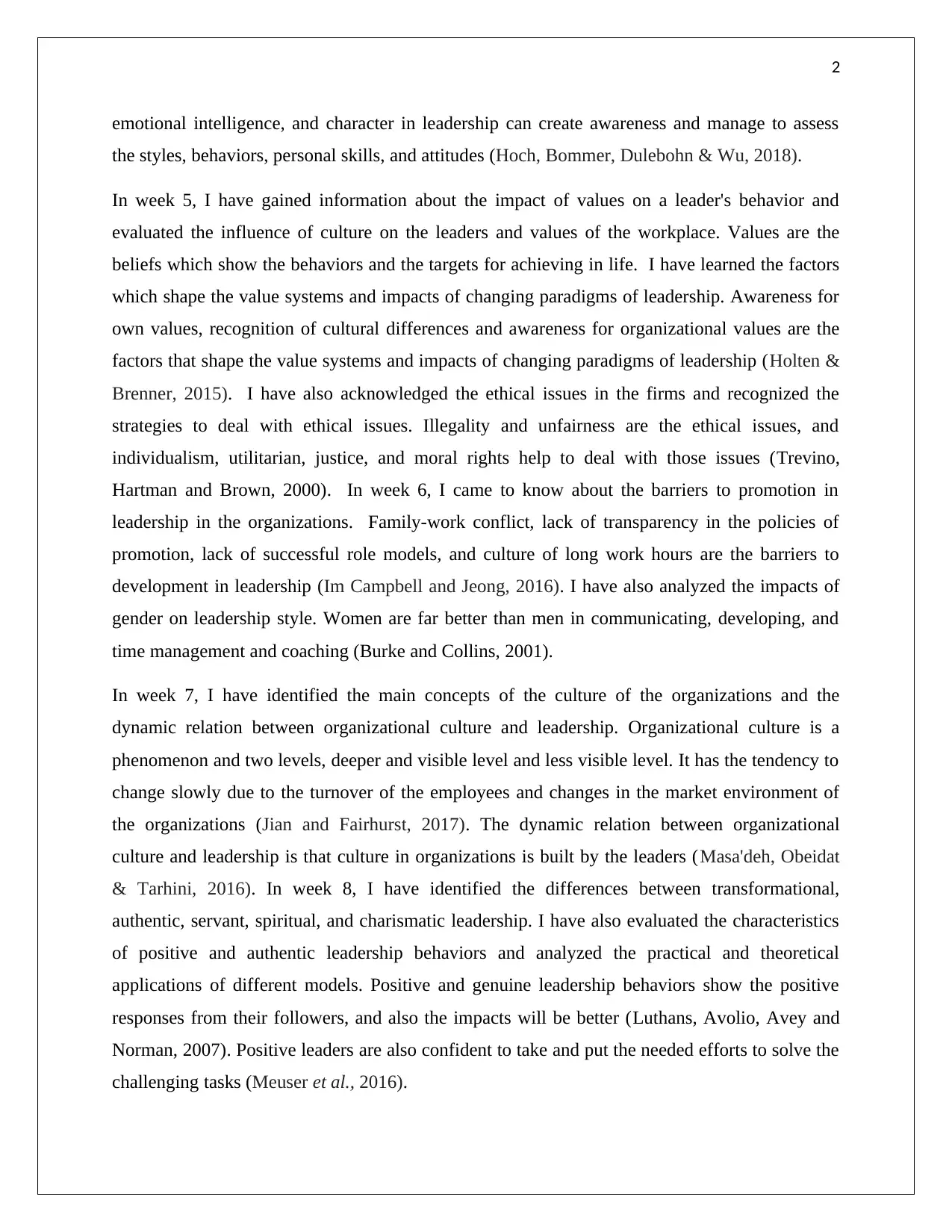
2
emotional intelligence, and character in leadership can create awareness and manage to assess
the styles, behaviors, personal skills, and attitudes (Hoch, Bommer, Dulebohn & Wu, 2018).
In week 5, I have gained information about the impact of values on a leader's behavior and
evaluated the influence of culture on the leaders and values of the workplace. Values are the
beliefs which show the behaviors and the targets for achieving in life. I have learned the factors
which shape the value systems and impacts of changing paradigms of leadership. Awareness for
own values, recognition of cultural differences and awareness for organizational values are the
factors that shape the value systems and impacts of changing paradigms of leadership (Holten &
Brenner, 2015). I have also acknowledged the ethical issues in the firms and recognized the
strategies to deal with ethical issues. Illegality and unfairness are the ethical issues, and
individualism, utilitarian, justice, and moral rights help to deal with those issues (Trevino,
Hartman and Brown, 2000). In week 6, I came to know about the barriers to promotion in
leadership in the organizations. Family-work conflict, lack of transparency in the policies of
promotion, lack of successful role models, and culture of long work hours are the barriers to
development in leadership (Im Campbell and Jeong, 2016). I have also analyzed the impacts of
gender on leadership style. Women are far better than men in communicating, developing, and
time management and coaching (Burke and Collins, 2001).
In week 7, I have identified the main concepts of the culture of the organizations and the
dynamic relation between organizational culture and leadership. Organizational culture is a
phenomenon and two levels, deeper and visible level and less visible level. It has the tendency to
change slowly due to the turnover of the employees and changes in the market environment of
the organizations (Jian and Fairhurst, 2017). The dynamic relation between organizational
culture and leadership is that culture in organizations is built by the leaders (Masa'deh, Obeidat
& Tarhini, 2016). In week 8, I have identified the differences between transformational,
authentic, servant, spiritual, and charismatic leadership. I have also evaluated the characteristics
of positive and authentic leadership behaviors and analyzed the practical and theoretical
applications of different models. Positive and genuine leadership behaviors show the positive
responses from their followers, and also the impacts will be better (Luthans, Avolio, Avey and
Norman, 2007). Positive leaders are also confident to take and put the needed efforts to solve the
challenging tasks (Meuser et al., 2016).
emotional intelligence, and character in leadership can create awareness and manage to assess
the styles, behaviors, personal skills, and attitudes (Hoch, Bommer, Dulebohn & Wu, 2018).
In week 5, I have gained information about the impact of values on a leader's behavior and
evaluated the influence of culture on the leaders and values of the workplace. Values are the
beliefs which show the behaviors and the targets for achieving in life. I have learned the factors
which shape the value systems and impacts of changing paradigms of leadership. Awareness for
own values, recognition of cultural differences and awareness for organizational values are the
factors that shape the value systems and impacts of changing paradigms of leadership (Holten &
Brenner, 2015). I have also acknowledged the ethical issues in the firms and recognized the
strategies to deal with ethical issues. Illegality and unfairness are the ethical issues, and
individualism, utilitarian, justice, and moral rights help to deal with those issues (Trevino,
Hartman and Brown, 2000). In week 6, I came to know about the barriers to promotion in
leadership in the organizations. Family-work conflict, lack of transparency in the policies of
promotion, lack of successful role models, and culture of long work hours are the barriers to
development in leadership (Im Campbell and Jeong, 2016). I have also analyzed the impacts of
gender on leadership style. Women are far better than men in communicating, developing, and
time management and coaching (Burke and Collins, 2001).
In week 7, I have identified the main concepts of the culture of the organizations and the
dynamic relation between organizational culture and leadership. Organizational culture is a
phenomenon and two levels, deeper and visible level and less visible level. It has the tendency to
change slowly due to the turnover of the employees and changes in the market environment of
the organizations (Jian and Fairhurst, 2017). The dynamic relation between organizational
culture and leadership is that culture in organizations is built by the leaders (Masa'deh, Obeidat
& Tarhini, 2016). In week 8, I have identified the differences between transformational,
authentic, servant, spiritual, and charismatic leadership. I have also evaluated the characteristics
of positive and authentic leadership behaviors and analyzed the practical and theoretical
applications of different models. Positive and genuine leadership behaviors show the positive
responses from their followers, and also the impacts will be better (Luthans, Avolio, Avey and
Norman, 2007). Positive leaders are also confident to take and put the needed efforts to solve the
challenging tasks (Meuser et al., 2016).
⊘ This is a preview!⊘
Do you want full access?
Subscribe today to unlock all pages.

Trusted by 1+ million students worldwide
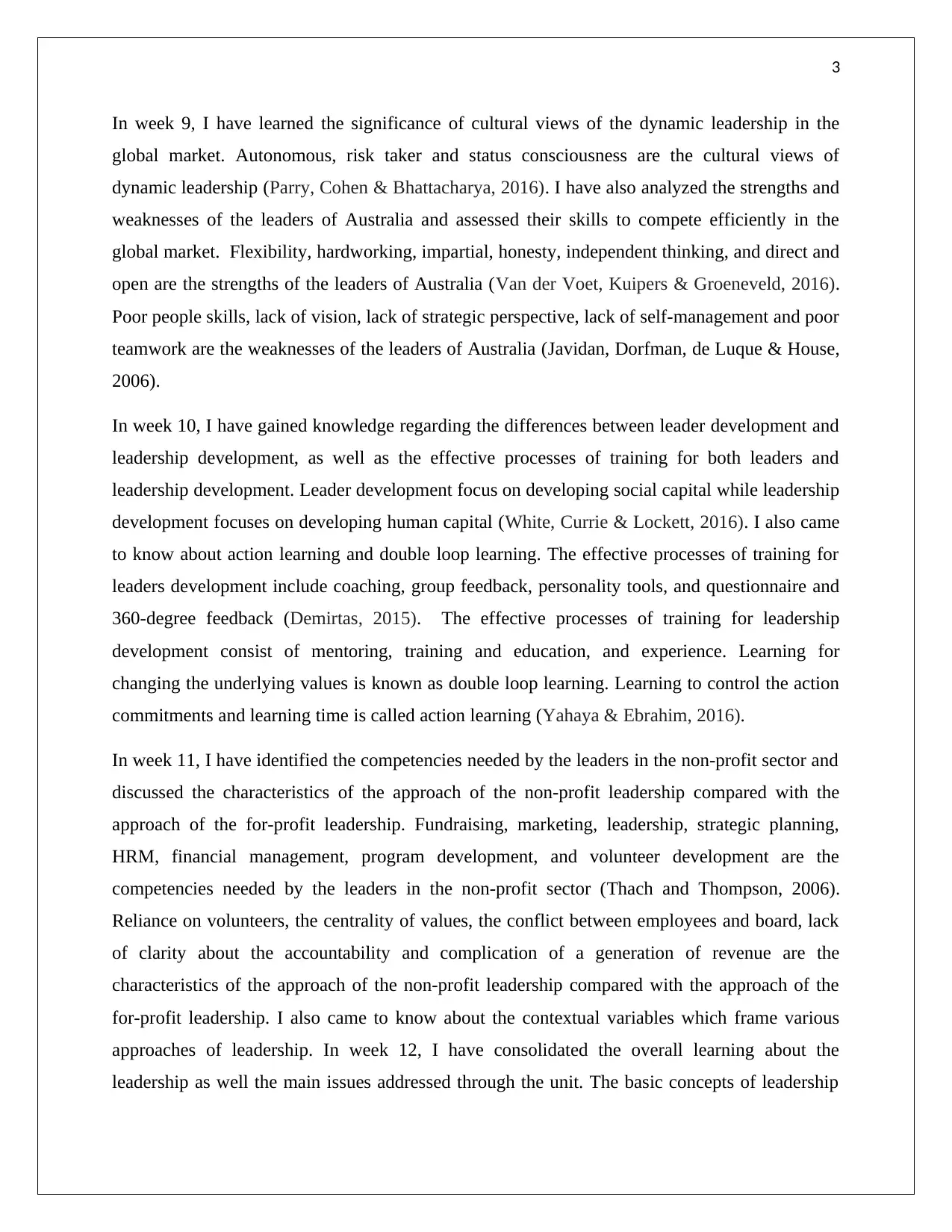
3
In week 9, I have learned the significance of cultural views of the dynamic leadership in the
global market. Autonomous, risk taker and status consciousness are the cultural views of
dynamic leadership (Parry, Cohen & Bhattacharya, 2016). I have also analyzed the strengths and
weaknesses of the leaders of Australia and assessed their skills to compete efficiently in the
global market. Flexibility, hardworking, impartial, honesty, independent thinking, and direct and
open are the strengths of the leaders of Australia (Van der Voet, Kuipers & Groeneveld, 2016).
Poor people skills, lack of vision, lack of strategic perspective, lack of self-management and poor
teamwork are the weaknesses of the leaders of Australia (Javidan, Dorfman, de Luque & House,
2006).
In week 10, I have gained knowledge regarding the differences between leader development and
leadership development, as well as the effective processes of training for both leaders and
leadership development. Leader development focus on developing social capital while leadership
development focuses on developing human capital (White, Currie & Lockett, 2016). I also came
to know about action learning and double loop learning. The effective processes of training for
leaders development include coaching, group feedback, personality tools, and questionnaire and
360-degree feedback (Demirtas, 2015). The effective processes of training for leadership
development consist of mentoring, training and education, and experience. Learning for
changing the underlying values is known as double loop learning. Learning to control the action
commitments and learning time is called action learning (Yahaya & Ebrahim, 2016).
In week 11, I have identified the competencies needed by the leaders in the non-profit sector and
discussed the characteristics of the approach of the non-profit leadership compared with the
approach of the for-profit leadership. Fundraising, marketing, leadership, strategic planning,
HRM, financial management, program development, and volunteer development are the
competencies needed by the leaders in the non-profit sector (Thach and Thompson, 2006).
Reliance on volunteers, the centrality of values, the conflict between employees and board, lack
of clarity about the accountability and complication of a generation of revenue are the
characteristics of the approach of the non-profit leadership compared with the approach of the
for-profit leadership. I also came to know about the contextual variables which frame various
approaches of leadership. In week 12, I have consolidated the overall learning about the
leadership as well the main issues addressed through the unit. The basic concepts of leadership
In week 9, I have learned the significance of cultural views of the dynamic leadership in the
global market. Autonomous, risk taker and status consciousness are the cultural views of
dynamic leadership (Parry, Cohen & Bhattacharya, 2016). I have also analyzed the strengths and
weaknesses of the leaders of Australia and assessed their skills to compete efficiently in the
global market. Flexibility, hardworking, impartial, honesty, independent thinking, and direct and
open are the strengths of the leaders of Australia (Van der Voet, Kuipers & Groeneveld, 2016).
Poor people skills, lack of vision, lack of strategic perspective, lack of self-management and poor
teamwork are the weaknesses of the leaders of Australia (Javidan, Dorfman, de Luque & House,
2006).
In week 10, I have gained knowledge regarding the differences between leader development and
leadership development, as well as the effective processes of training for both leaders and
leadership development. Leader development focus on developing social capital while leadership
development focuses on developing human capital (White, Currie & Lockett, 2016). I also came
to know about action learning and double loop learning. The effective processes of training for
leaders development include coaching, group feedback, personality tools, and questionnaire and
360-degree feedback (Demirtas, 2015). The effective processes of training for leadership
development consist of mentoring, training and education, and experience. Learning for
changing the underlying values is known as double loop learning. Learning to control the action
commitments and learning time is called action learning (Yahaya & Ebrahim, 2016).
In week 11, I have identified the competencies needed by the leaders in the non-profit sector and
discussed the characteristics of the approach of the non-profit leadership compared with the
approach of the for-profit leadership. Fundraising, marketing, leadership, strategic planning,
HRM, financial management, program development, and volunteer development are the
competencies needed by the leaders in the non-profit sector (Thach and Thompson, 2006).
Reliance on volunteers, the centrality of values, the conflict between employees and board, lack
of clarity about the accountability and complication of a generation of revenue are the
characteristics of the approach of the non-profit leadership compared with the approach of the
for-profit leadership. I also came to know about the contextual variables which frame various
approaches of leadership. In week 12, I have consolidated the overall learning about the
leadership as well the main issues addressed through the unit. The basic concepts of leadership
Paraphrase This Document
Need a fresh take? Get an instant paraphrase of this document with our AI Paraphraser
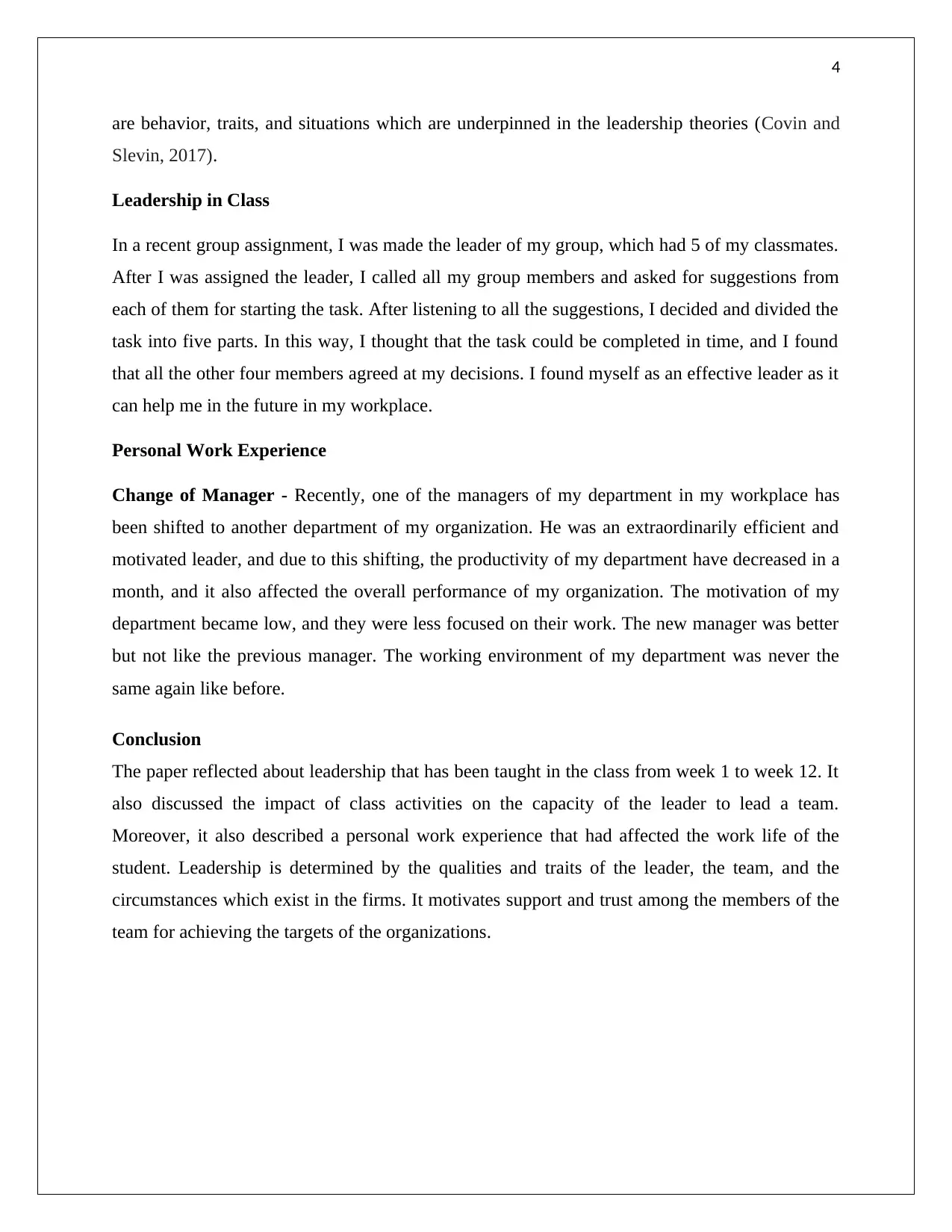
4
are behavior, traits, and situations which are underpinned in the leadership theories (Covin and
Slevin, 2017).
Leadership in Class
In a recent group assignment, I was made the leader of my group, which had 5 of my classmates.
After I was assigned the leader, I called all my group members and asked for suggestions from
each of them for starting the task. After listening to all the suggestions, I decided and divided the
task into five parts. In this way, I thought that the task could be completed in time, and I found
that all the other four members agreed at my decisions. I found myself as an effective leader as it
can help me in the future in my workplace.
Personal Work Experience
Change of Manager - Recently, one of the managers of my department in my workplace has
been shifted to another department of my organization. He was an extraordinarily efficient and
motivated leader, and due to this shifting, the productivity of my department have decreased in a
month, and it also affected the overall performance of my organization. The motivation of my
department became low, and they were less focused on their work. The new manager was better
but not like the previous manager. The working environment of my department was never the
same again like before.
Conclusion
The paper reflected about leadership that has been taught in the class from week 1 to week 12. It
also discussed the impact of class activities on the capacity of the leader to lead a team.
Moreover, it also described a personal work experience that had affected the work life of the
student. Leadership is determined by the qualities and traits of the leader, the team, and the
circumstances which exist in the firms. It motivates support and trust among the members of the
team for achieving the targets of the organizations.
are behavior, traits, and situations which are underpinned in the leadership theories (Covin and
Slevin, 2017).
Leadership in Class
In a recent group assignment, I was made the leader of my group, which had 5 of my classmates.
After I was assigned the leader, I called all my group members and asked for suggestions from
each of them for starting the task. After listening to all the suggestions, I decided and divided the
task into five parts. In this way, I thought that the task could be completed in time, and I found
that all the other four members agreed at my decisions. I found myself as an effective leader as it
can help me in the future in my workplace.
Personal Work Experience
Change of Manager - Recently, one of the managers of my department in my workplace has
been shifted to another department of my organization. He was an extraordinarily efficient and
motivated leader, and due to this shifting, the productivity of my department have decreased in a
month, and it also affected the overall performance of my organization. The motivation of my
department became low, and they were less focused on their work. The new manager was better
but not like the previous manager. The working environment of my department was never the
same again like before.
Conclusion
The paper reflected about leadership that has been taught in the class from week 1 to week 12. It
also discussed the impact of class activities on the capacity of the leader to lead a team.
Moreover, it also described a personal work experience that had affected the work life of the
student. Leadership is determined by the qualities and traits of the leader, the team, and the
circumstances which exist in the firms. It motivates support and trust among the members of the
team for achieving the targets of the organizations.
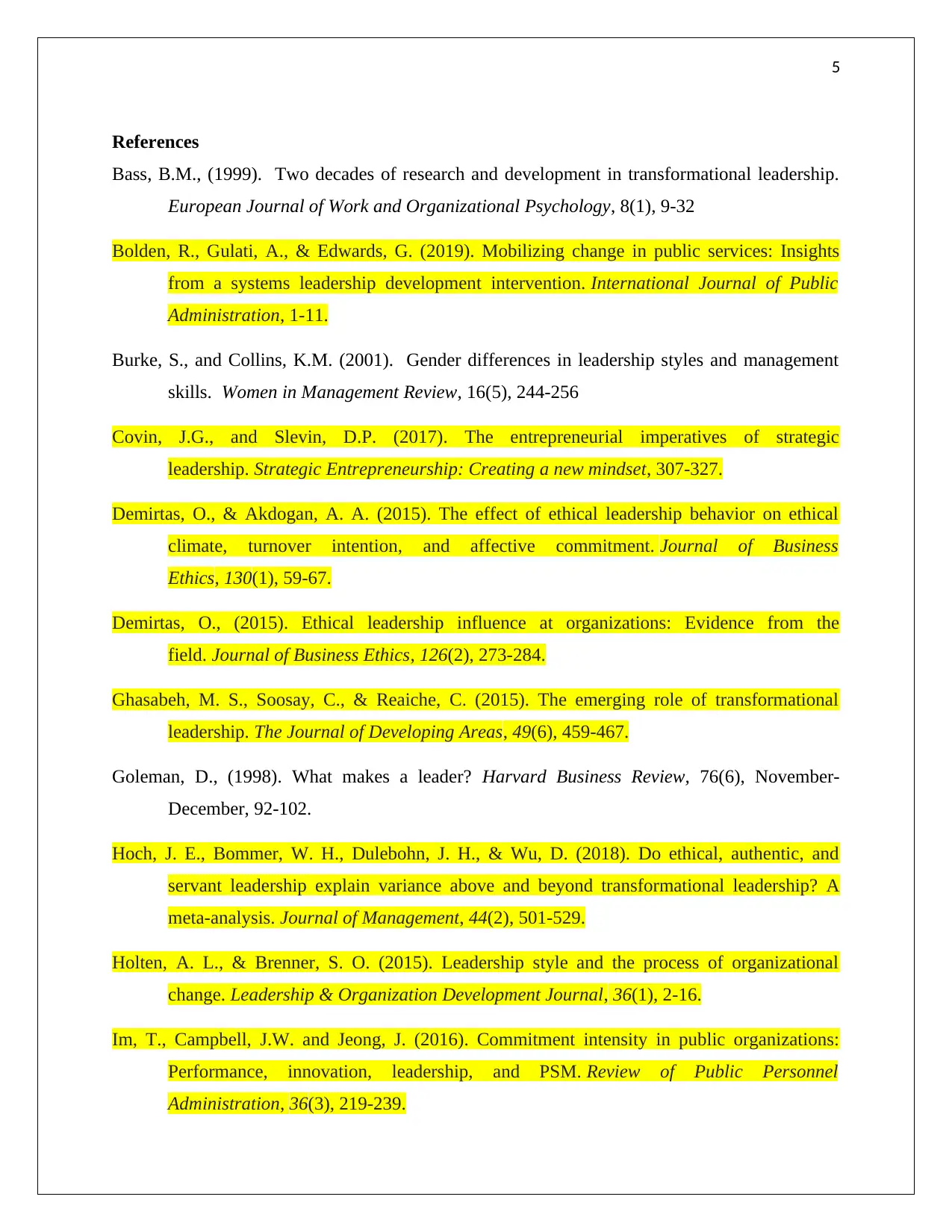
5
References
Bass, B.M., (1999). Two decades of research and development in transformational leadership.
European Journal of Work and Organizational Psychology, 8(1), 9-32
Bolden, R., Gulati, A., & Edwards, G. (2019). Mobilizing change in public services: Insights
from a systems leadership development intervention. International Journal of Public
Administration, 1-11.
Burke, S., and Collins, K.M. (2001). Gender differences in leadership styles and management
skills. Women in Management Review, 16(5), 244-256
Covin, J.G., and Slevin, D.P. (2017). The entrepreneurial imperatives of strategic
leadership. Strategic Entrepreneurship: Creating a new mindset, 307-327.
Demirtas, O., & Akdogan, A. A. (2015). The effect of ethical leadership behavior on ethical
climate, turnover intention, and affective commitment. Journal of Business
Ethics, 130(1), 59-67.
Demirtas, O., (2015). Ethical leadership influence at organizations: Evidence from the
field. Journal of Business Ethics, 126(2), 273-284.
Ghasabeh, M. S., Soosay, C., & Reaiche, C. (2015). The emerging role of transformational
leadership. The Journal of Developing Areas, 49(6), 459-467.
Goleman, D., (1998). What makes a leader? Harvard Business Review, 76(6), November-
December, 92-102.
Hoch, J. E., Bommer, W. H., Dulebohn, J. H., & Wu, D. (2018). Do ethical, authentic, and
servant leadership explain variance above and beyond transformational leadership? A
meta-analysis. Journal of Management, 44(2), 501-529.
Holten, A. L., & Brenner, S. O. (2015). Leadership style and the process of organizational
change. Leadership & Organization Development Journal, 36(1), 2-16.
Im, T., Campbell, J.W. and Jeong, J. (2016). Commitment intensity in public organizations:
Performance, innovation, leadership, and PSM. Review of Public Personnel
Administration, 36(3), 219-239.
References
Bass, B.M., (1999). Two decades of research and development in transformational leadership.
European Journal of Work and Organizational Psychology, 8(1), 9-32
Bolden, R., Gulati, A., & Edwards, G. (2019). Mobilizing change in public services: Insights
from a systems leadership development intervention. International Journal of Public
Administration, 1-11.
Burke, S., and Collins, K.M. (2001). Gender differences in leadership styles and management
skills. Women in Management Review, 16(5), 244-256
Covin, J.G., and Slevin, D.P. (2017). The entrepreneurial imperatives of strategic
leadership. Strategic Entrepreneurship: Creating a new mindset, 307-327.
Demirtas, O., & Akdogan, A. A. (2015). The effect of ethical leadership behavior on ethical
climate, turnover intention, and affective commitment. Journal of Business
Ethics, 130(1), 59-67.
Demirtas, O., (2015). Ethical leadership influence at organizations: Evidence from the
field. Journal of Business Ethics, 126(2), 273-284.
Ghasabeh, M. S., Soosay, C., & Reaiche, C. (2015). The emerging role of transformational
leadership. The Journal of Developing Areas, 49(6), 459-467.
Goleman, D., (1998). What makes a leader? Harvard Business Review, 76(6), November-
December, 92-102.
Hoch, J. E., Bommer, W. H., Dulebohn, J. H., & Wu, D. (2018). Do ethical, authentic, and
servant leadership explain variance above and beyond transformational leadership? A
meta-analysis. Journal of Management, 44(2), 501-529.
Holten, A. L., & Brenner, S. O. (2015). Leadership style and the process of organizational
change. Leadership & Organization Development Journal, 36(1), 2-16.
Im, T., Campbell, J.W. and Jeong, J. (2016). Commitment intensity in public organizations:
Performance, innovation, leadership, and PSM. Review of Public Personnel
Administration, 36(3), 219-239.
⊘ This is a preview!⊘
Do you want full access?
Subscribe today to unlock all pages.

Trusted by 1+ million students worldwide

6
Javidan, M., Dorfman, P., de Luque M. & House, R. (2006). Cross-Cultural Lessons in
leadership from Project GLOBE. Academy of Management Perspectives vol 20, no 1, 67-
90
Jian, G. and Fairhurst, G.T. (2017). Leadership in organizations. The international encyclopedia
of organizational communication, 1-20.
Luthans, F., Avolio, B.J., Avey, J.B., and Norman, N. (2007) Positive Psychological Capital:
Measure and Relationship with Performance and Satisfaction. Personnel Psychology. 60:
3; 541-573.
Masa'deh, R. E., Obeidat, B. Y., & Tarhini, A. (2016). A Jordanian empirical study of the
associations among transformational leadership, transactional leadership, knowledge
sharing, job performance, and firm performance: A structural equation modelling
approach. Journal of Management Development, 35(5), 681-705.
Meuser, J. D., Gardner, W. L., Dinh, J. E., Hu, J., Liden, R. C., & Lord, R. G. (2016). A network
analysis of leadership theory: The infancy of integration. Journal of Management, 42(5),
1374-1403.
Nicholson, N. (2013) ‘The Invention of Leadership’ Business Strategy. Review no 2, 14-29.
Offermann, L.R., Kennedy, J.K., and Wirtz, P.W. (1994). Implicit leadership theories: content,
structure, and generalizability. Leadership Quarterly, 5(1), 43-58
Parry, K., Cohen, M., & Bhattacharya, S. (2016). Rise of the machines: A critical consideration
of automated leadership decision making in organizations. Group & Organization
Management, 41(5), 571-594.
Thach, E. and Thompson, K.J. (2006) Trading Places: Examining leadership competencies
between for-profit vs. public and non-profit leaders. Leadership and Organization
Development Journal. 28:4, 356-375
Trevino, L.K., Hartman, L.P., and Brown, M. (2000). Moral person and moral manager: how
executives develop a reputation for ethical leadership. California Management Review,
42(4), 128-142.
Javidan, M., Dorfman, P., de Luque M. & House, R. (2006). Cross-Cultural Lessons in
leadership from Project GLOBE. Academy of Management Perspectives vol 20, no 1, 67-
90
Jian, G. and Fairhurst, G.T. (2017). Leadership in organizations. The international encyclopedia
of organizational communication, 1-20.
Luthans, F., Avolio, B.J., Avey, J.B., and Norman, N. (2007) Positive Psychological Capital:
Measure and Relationship with Performance and Satisfaction. Personnel Psychology. 60:
3; 541-573.
Masa'deh, R. E., Obeidat, B. Y., & Tarhini, A. (2016). A Jordanian empirical study of the
associations among transformational leadership, transactional leadership, knowledge
sharing, job performance, and firm performance: A structural equation modelling
approach. Journal of Management Development, 35(5), 681-705.
Meuser, J. D., Gardner, W. L., Dinh, J. E., Hu, J., Liden, R. C., & Lord, R. G. (2016). A network
analysis of leadership theory: The infancy of integration. Journal of Management, 42(5),
1374-1403.
Nicholson, N. (2013) ‘The Invention of Leadership’ Business Strategy. Review no 2, 14-29.
Offermann, L.R., Kennedy, J.K., and Wirtz, P.W. (1994). Implicit leadership theories: content,
structure, and generalizability. Leadership Quarterly, 5(1), 43-58
Parry, K., Cohen, M., & Bhattacharya, S. (2016). Rise of the machines: A critical consideration
of automated leadership decision making in organizations. Group & Organization
Management, 41(5), 571-594.
Thach, E. and Thompson, K.J. (2006) Trading Places: Examining leadership competencies
between for-profit vs. public and non-profit leaders. Leadership and Organization
Development Journal. 28:4, 356-375
Trevino, L.K., Hartman, L.P., and Brown, M. (2000). Moral person and moral manager: how
executives develop a reputation for ethical leadership. California Management Review,
42(4), 128-142.
Paraphrase This Document
Need a fresh take? Get an instant paraphrase of this document with our AI Paraphraser
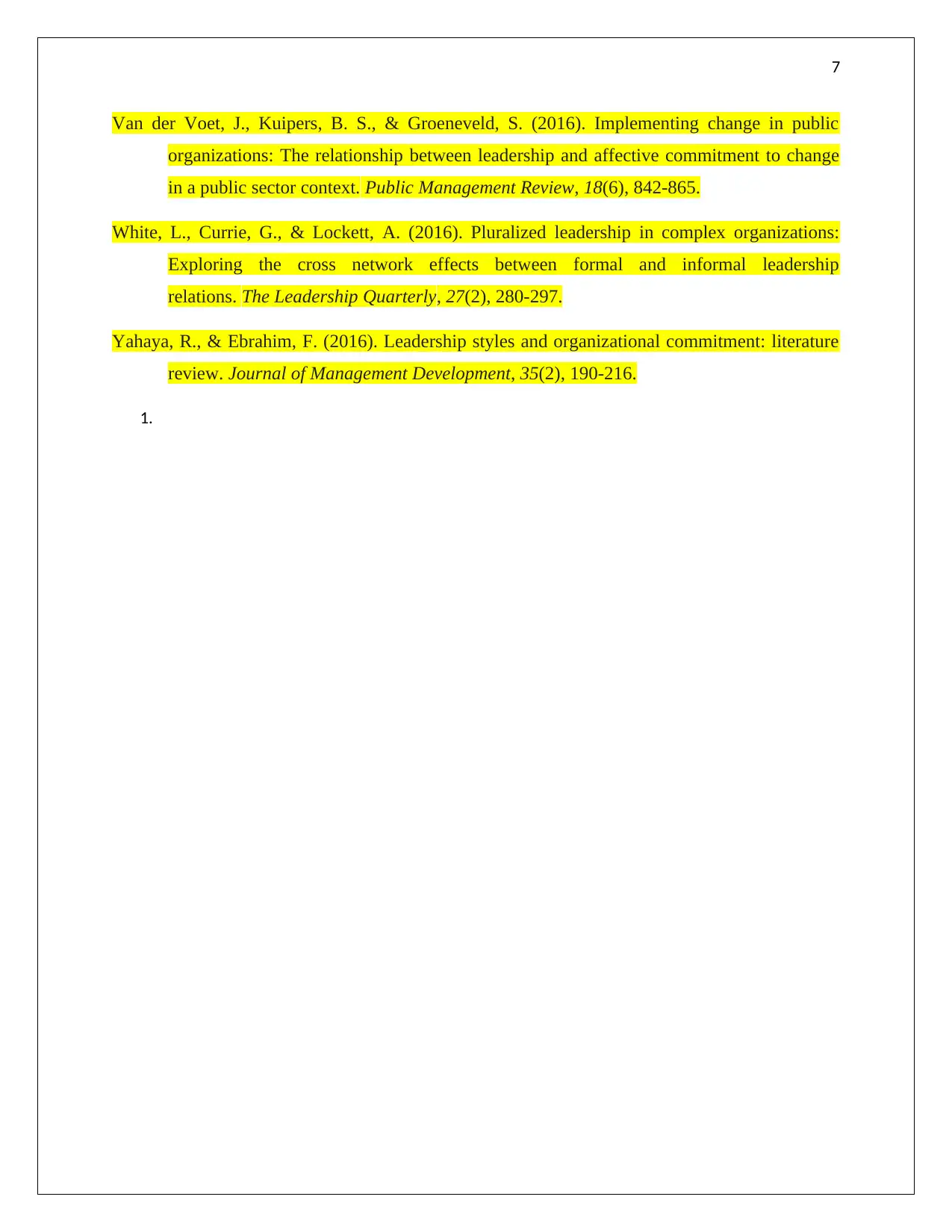
7
Van der Voet, J., Kuipers, B. S., & Groeneveld, S. (2016). Implementing change in public
organizations: The relationship between leadership and affective commitment to change
in a public sector context. Public Management Review, 18(6), 842-865.
White, L., Currie, G., & Lockett, A. (2016). Pluralized leadership in complex organizations:
Exploring the cross network effects between formal and informal leadership
relations. The Leadership Quarterly, 27(2), 280-297.
Yahaya, R., & Ebrahim, F. (2016). Leadership styles and organizational commitment: literature
review. Journal of Management Development, 35(2), 190-216.
1.
Van der Voet, J., Kuipers, B. S., & Groeneveld, S. (2016). Implementing change in public
organizations: The relationship between leadership and affective commitment to change
in a public sector context. Public Management Review, 18(6), 842-865.
White, L., Currie, G., & Lockett, A. (2016). Pluralized leadership in complex organizations:
Exploring the cross network effects between formal and informal leadership
relations. The Leadership Quarterly, 27(2), 280-297.
Yahaya, R., & Ebrahim, F. (2016). Leadership styles and organizational commitment: literature
review. Journal of Management Development, 35(2), 190-216.
1.

8
⊘ This is a preview!⊘
Do you want full access?
Subscribe today to unlock all pages.

Trusted by 1+ million students worldwide
1 out of 9
Related Documents
Your All-in-One AI-Powered Toolkit for Academic Success.
+13062052269
info@desklib.com
Available 24*7 on WhatsApp / Email
![[object Object]](/_next/static/media/star-bottom.7253800d.svg)
Unlock your academic potential
Copyright © 2020–2025 A2Z Services. All Rights Reserved. Developed and managed by ZUCOL.





